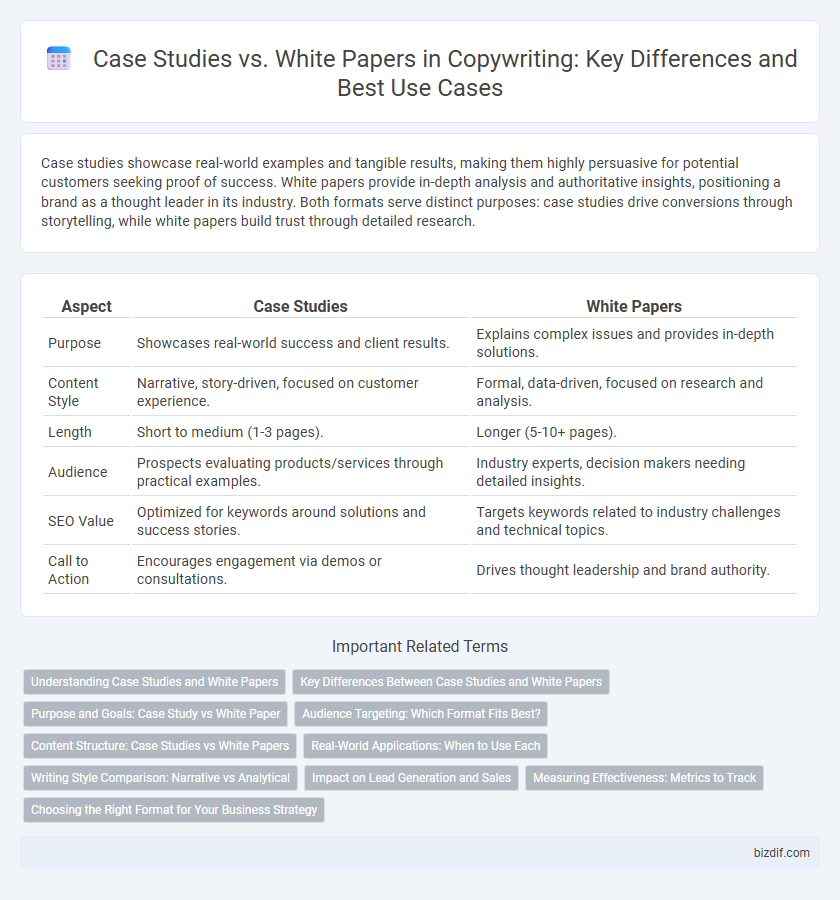Case studies showcase real-world examples and tangible results, making them highly persuasive for potential customers seeking proof of success. White papers provide in-depth analysis and authoritative insights, positioning a brand as a thought leader in its industry. Both formats serve distinct purposes: case studies drive conversions through storytelling, while white papers build trust through detailed research.
Table of Comparison
| Aspect | Case Studies | White Papers |
|---|---|---|
| Purpose | Showcases real-world success and client results. | Explains complex issues and provides in-depth solutions. |
| Content Style | Narrative, story-driven, focused on customer experience. | Formal, data-driven, focused on research and analysis. |
| Length | Short to medium (1-3 pages). | Longer (5-10+ pages). |
| Audience | Prospects evaluating products/services through practical examples. | Industry experts, decision makers needing detailed insights. |
| SEO Value | Optimized for keywords around solutions and success stories. | Targets keywords related to industry challenges and technical topics. |
| Call to Action | Encourages engagement via demos or consultations. | Drives thought leadership and brand authority. |
Understanding Case Studies and White Papers
Case studies provide real-world examples showcasing a product's impact by illustrating specific client challenges, solutions implemented, and measurable results achieved, making them highly relatable and persuasive. White papers offer in-depth research and analysis on industry trends or technical topics, delivering authoritative insights and data-driven evidence to support decision-making processes. Both formats serve distinct purposes: case studies highlight practical application and success stories, while white papers emphasize thought leadership and comprehensive subject expertise.
Key Differences Between Case Studies and White Papers
Case studies provide in-depth analysis of specific client experiences showcasing practical applications and measurable outcomes, emphasizing real-world problem-solving and results. White papers deliver comprehensive explorations of industry issues, presenting research, data, and expert insights to inform decision-making and promote thought leadership. Both formats serve distinct purposes in content marketing: case studies build credibility through storytelling, while white papers establish authority through detailed analysis.
Purpose and Goals: Case Study vs White Paper
Case studies aim to demonstrate real-world applications and tangible results of a product or service, focusing on storytelling and client success to build trust and credibility. White papers provide in-depth analysis, research, and expert insights to educate the audience and establish thought leadership on industry-specific topics. Both formats serve as strategic tools in content marketing, with case studies driving conversion through proof and white papers fostering informed decision-making.
Audience Targeting: Which Format Fits Best?
Case studies effectively target potential clients seeking relatable, real-world examples of product or service success, offering tangible proof of benefits and results. White papers cater to decision-makers and industry experts looking for in-depth analysis, data-driven insights, and authoritative information to support strategic decisions. Choosing between these formats depends on whether the goal is to highlight practical application and client outcomes or to provide comprehensive research and thought leadership.
Content Structure: Case Studies vs White Papers
Case studies emphasize a narrative structure, showcasing a specific problem, the implemented solution, and measurable results to engage readers with real-world applications. White papers adopt a formal, research-driven framework, presenting in-depth analysis, data, and expert insights to establish thought leadership and guide decision-making. Both formats require clear headings and concise, targeted content but differ in tone and detail depth to suit their distinct strategic purposes.
Real-World Applications: When to Use Each
Case studies showcase real-world applications by highlighting specific customer success stories, making them ideal for demonstrating practical benefits and outcomes to potential clients. White papers provide in-depth analysis and expert insights on industry challenges or innovations, positioning the brand as a thought leader while educating the audience. Use case studies to build trust through relatable narratives and white papers to support decision-making with detailed research and strategic guidance.
Writing Style Comparison: Narrative vs Analytical
Case studies use a narrative writing style, emphasizing storytelling to illustrate real-world applications and client success, creating an engaging and relatable experience for readers. White papers employ an analytical writing style, focusing on data-driven analysis, detailed research, and logical arguments to inform and persuade a professional audience. The narrative approach in case studies builds emotional connection, while the analytical style in white papers establishes credibility and authority.
Impact on Lead Generation and Sales
Case studies boost lead generation by showcasing real-world success stories, building trust and credibility with potential customers. White papers establish thought leadership through in-depth research and expert insights, attracting qualified leads seeking detailed information. Combining both formats enhances sales by addressing different buyer stages--case studies for emotional engagement and white papers for rational decision-making.
Measuring Effectiveness: Metrics to Track
Measuring effectiveness in copywriting involves analyzing metrics such as engagement rates, conversion rates, and lead generation for both case studies and white papers. Case studies often excel in tracking customer testimonials and real-world outcomes, providing tangible proof of product value, while white papers focus on thought leadership metrics like download rates, time spent on page, and citation frequency. Comparing these metrics helps marketers determine which format drives higher ROI and better aligns with audience decision-making processes.
Choosing the Right Format for Your Business Strategy
Case studies provide compelling, real-world examples that highlight customer success and practical application, making them ideal for illustrating tangible results in your business strategy. White papers offer in-depth research and detailed analysis, positioning your company as a thought leader and addressing complex issues with authoritative insights. Selecting the right format depends on whether your goal is to build trust through storytelling or establish expertise through comprehensive information.
Case Studies vs White Papers Infographic

 bizdif.com
bizdif.com